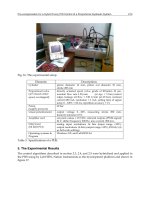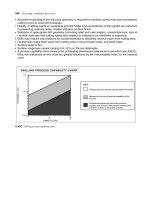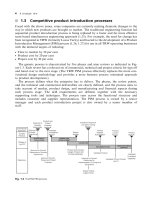McGraw-Hill- PDA Robotics - Using Your PDA to Control Your Robot 1 Part 12 ppsx
Bạn đang xem bản rút gọn của tài liệu. Xem và tải ngay bản đầy đủ của tài liệu tại đây (256.57 KB, 20 trang )
//
// Activate the motion detection
//
CAPTUREPARMS cap_params;
long struct_size = sizeof( CAPTUREPARMS );
capCaptureGetSetup( h_capwin, &cap_params, struct_size);
cap_params.fLimitEnabled = FALSE;
cap_params.fAbortLeftMouse = FALSE;
cap_params.fAbortRightMouse = FALSE;
cap_params.wTimeLimit = 3600; // reset after 60 second test
cap_params.fYield = TRUE;
//
// Throw away the audio for now will use same algorithm
// for sound detection
//
cap_params.fCaptureAudio = FALSE;
cap_params.wNumVideoRequested = 1;
capCaptureSetSetup( h_capwin, &cap_params, struct_size);
//
// Set the callback to which the vidoe will be stramed
//
BOOL ret = capSetCallbackOnVideoStream( h_capwin, (LPVOID) stream_callback );
capCaptureSequenceNoFile( h_capwin );
}else{
//
// Unchecked the motion detection
//
m_radar_stat.SetWindowText("Motion Sense : OFF");
capCaptureAbort(h_capwin);
m_stretch_video.EnableWindow(TRUE);
}
}
The video frames will be sent to this callback function where we will
compare the last video frame sent to the current
LRESULT stream_callback(HWND hWnd, LPVIDEOHDR lpVHdr)
{
static initialized;
static DWORD frame_same_total;
static last_frame_bytes;
PDA Robotics
198
PDA 10 5/27/03 8:51 AM Page 198
static DWORD trigger_threshold;
static BYTE *last_frame_data;
BYTE *frame_data = (BYTE *) malloc((size_t)lpVHdr->dwBytesUsed);
//
// We will run into a problem if the frame buffer size has
// increased ( user switched the video format settings while
// detecting motion ).so realloc to the correct size.
//
if( !initialized ){
last_frame_data = (BYTE *) malloc((size_t)lpVHdr->dwBytesUsed);
last_frame_bytes = (size_t)lpVHdr->dwBytesUsed;
}
else
{
// Ensure that the bytes used hasn't changed. User may change
// video settings along the way. Resize our frame buffer
if( last_frame_bytes != (size_t)lpVHdr->dwBytesUsed )
{
// AfxMessageBox( " Reallocating the frame buffer sise !" );
last_frame_data = (BYTE *) realloc(last_frame_data,
(size_t)lpVHdr->dwBytesUsed);
last_frame_bytes = (size_t)lpVHdr->dwBytesUsed;
}
}
if( (frame_data == NULL ) || ( last_frame_data == NULL ) )
{
//
// Frame data couldn't be allocated
//
return FALSE;
}
memcpy( frame_data, lpVHdr->lpData, lpVHdr->dwBytesUsed);
if( !initialized )
{
memcpy( last_frame_data, frame_data, lpVHdr->dwBytesUsed);
frames_sampled = 0;
frame_same_total = 0;
initialized = 1;
}
void *frame_data_star t = frame_data;
void *last_frame_data_star t = last_frame_data;
//
Chapter 10 / The PDA Robotics Command Center
199
PDA 10 5/27/03 8:51 AM Page 199
// Scan through the frames comparing the last to the new
//
long same_count = 0;
for ( DWORD i = 0; i < lpVHdr->dwBytesUsed; i++ )
{
if( *frame_data == *last_frame_data )
{
same_count++;
}
frame_data++;
last_frame_data++;
}
//
// Reset our pointers or we are wading through deep @#*!
//
frame_data = (BYTE *) frame_data_start;
last_frame_data = (BYTE *) last_frame_data_start;
if( frames_sampled < 5 )
{
if(frames_sampled > 0 )
{
frame_same_total += same_count;
average_frame_similarity = frame_same_total / frames_sampled;
trigger_threshold = ( average_frame_similarity / 30 ) *
global_detection_threshold;
}
frames_sampled++;
}
//
// If the slider has been moved recalculate
//
if( recalculate_threshold == 1 )
{
trigger_threshold = ( average_frame_similarity / 30 ) * global_detection_threshold;
recalculate_threshold = 0;
}
//
// Note : If sound capture is activated you can detect the *wave*
// cap_params.fCaptureAudio = TRUE;
//
//
// If we are over the threshold then motion has been detected
PDA Robotics
200
PDA 10 5/27/03 8:51 AM Page 200
//
if( ( same_count < trigger_threshold ) && ( frames_sampled >= 4 ) )
{
detected_motion = TRUE;
//
// Stop the streaming and grab a frame
//
capCaptureAbort(h_capwin);
capGrabFrame(h_capwin);
initialized = 0;
//
// TODO: ENSURE no mem leakage
//
AfxGetMainWnd()->SetTimer(CLEAR_MOTION_DETECT ,50, NULL);
return TRUE;
}
else
{
detected_motion = FALSE;
}
//
// Save the last frame
//
memcpy( last_frame_data, frame_data, lpVHdr->dwBytesUsed );
free(frame_data);
return TRUE;
}
When motion is detected, the program will save an image and forward
it via FTP or SMTP (mail).
Sending Data Using FTP
class CFtp
{
public:
CFtp();
~CFtp();
Chapter 10 / The PDA Robotics Command Center
201
PDA 10 5/27/03 8:51 AM Page 201
BOOL UpdateFtpFile( CString host,
CString user,
CString password,
CString remote_path,
CString filename,
CString remote_filename,
CString& status_msg );
BOOL CFtp::TestConnect( CString host,
CString user,
CString password,
INTERNET_PORT por t,
CString& status_msg);
protected:
CInternetSession* m_pInetSession; // objects one and only session
CFtpConnection* m_pFtpConnection; // If you need another create another Cftp
};
CFtp::CFtp()
{
m_pFtpConnection = NULL;
// the CInternetSession will not be closed or deleted
// until the dialog is closed
CString str;
if (!str.LoadString(IDS_APPNAME))
str = _T("AppUnknown");
m_pInetSession = new CInternetSession(str, 1, PRE_CONFIG_INTERNET_ACCESS);
// Aler t the user if the internet session could
// not be star ted and close app
if (!m_pInetSession)
{
AfxMessageBox(IDS_BAD_SESSION, MB_OK);
OnCancel();
}
}
// Destructor
CFtp::~CFtp()
PDA Robotics
202
PDA 10 5/27/03 8:51 AM Page 202
{
// clean up any objects that are still lying around
if (m_pFtpConnection != NULL)
{
m_pFtpConnection->Close();
delete m_pFtpConnection;
}
if (m_pInetSession != NULL)
{
m_pInetSession->Close();
delete m_pInetSession;
}
}
// Update our file
BOOL CFtp::UpdateFtpFile(CString host, CString user, CString password, CString
remote_path, CString filename, CString remote_filename, CString& status_msg)
{
CString strFtpSite;
CString strSer verName;
CString strObject;
INTERNET_PORT nPor t;
DWORD dwSer viceType;
if (!AfxParseURL(ftp_host, dwServiceType, strServerName, strObject, nPort))
{
// tr y adding the "ftp://" protocol
CString strFtpURL = _T("ftp://");
strFtpURL += host;
if (!AfxParseURL(strFtpURL, dwServiceType, strServerName, strObject, nPort))
{
// AfxMessageBox(IDS_INVALID_URL, MB_OK);
// m_FtpTreeCtl.PopulateTree();
status_msg = "Bad URL, please check host name";
return(FALSE);
}
}
// If the user has provided all the information in the
// host line then dwServiceType, strServerName, strObject, nPort will
// be filled in but since I've provided edit boxes for each we will use these.
// Now open an FTP connection to the server
if ((dwSer viceType == INTERNET_SERVICE_FTP) && !strServerName.IsEmpty())
{
try
{
Chapter 10 / The PDA Robotics Command Center
203
PDA 10 5/27/03 8:51 AM Page 203
m_pFtpConnection = m_pInetSession->GetFtpConnection(strServerName, user,
password, 21 );
}
catch (CInternetException* pEx)
{
// catch errors from WinINet
TCHAR szErr[1024];
if (pEx->GetErrorMessage(szErr, 1024))
// AfxMessageBox(szErr, MB_OK);
status_msg = szErr;
else
status_msg = szErr;
//AfxMessageBox(IDS_EXCEPTION, MB_OK);
pEx->Delete();
m_pFtpConnection = NULL;
return(FALSE);
}
}
else
{
status_msg = "Bad URL, please check host name";
}
BOOL rcode = m_pFtpConnection->SetCurrentDirectory(remote_path);
if( FALSE == rcode )
{
status_msg = "Could not goto directory specified. Please re enter";
}
CString strDirName;
rcode = m_pFtpConnection->GetCurrentDirector y(strDirName );
rcode = m_pFtpConnection->PutFile( filename, (LPCTSTR) remote_filename,
FTP_TRANSFER_TYPE_BINARY, 1 );
if( FALSE == rcode )
{
status_msg = "Could not update file. Check settings";
return(FALSE);
}
return(TRUE);
}
// Test connection
BOOL CFtp::TestConnect(CString host, CString user, CString password, INTERNET_PORT
port, CString& status_msg)
{
PDA Robotics
204
PDA 10 5/27/03 8:51 AM Page 204
CString strFtpSite;
CString strSer verName;
CString strObject;
INTERNET_PORT nPor t;
DWORD dwSer viceType;
// If the user has provided all the information in the
// host line then dwServiceType, strServerName, strObject, nPort will
// be filled in but since I've provided edit boxes
// for each we will use these.
//
// Ensure Valid connection parameters
//
CString diagnostic_msg = "";
if ( host.IsEmpty() )
{
diagnostic_msg = " check Host ";
}
if ( ( user.IsEmpty()) || (user == "") )
{
diagnostic_msg = " check Username ";
}
if ( password.IsEmpty() )
{
diagnostic_msg = " check password ";
}
if ( port < 1 )
{
diagnostic_msg = " check port ";
}
// Now open an FTP connection to the server
try
{
m_pFtpConnection = m_pInetSession->GetFtpConnection(host, user, password, port );
}
catch (CInternetException* pEx)
{
// catch errors from WinINet
TCHAR szErr[1024];
if (pEx->GetErrorMessage(szErr, 1024))
{
// AfxMessageBox(szErr, MB_OK);
status_msg += diagnostic_msg;
status_msg += szErr;
Chapter 10 / The PDA Robotics Command Center
205
PDA 10 5/27/03 8:51 AM Page 205
}else{
status_msg += diagnostic_msg;
status_msg = szErr;
}
//AfxMessageBox(IDS_EXCEPTION, MB_OK);
pEx->Delete();
m_pFtpConnection = NULL;
return(FALSE);
}
return(TRUE);
}
The Wireless Data Link
On startup, the command center listens on a socket for a connection
request from the PDA controlling PDA Robot. The listening socket is
derived from the CCeSocket, as is the socket created on the PDA.
#include "stdafx.h"
CListeningSocket::CListeningSocket(CBeamDlg* pDoc)
void CListeningSocket::OnAccept(int nErrorCode)
{
CSocket::OnAccept(nErrorCode);
m_pDlg->ProcessPendingAccept();
}
CListeningSocket::~CListeningSocket()
{
}
IMPLEMENT_DYNAMIC(CListeningSocket, CSocket)
The Main Dialog window of the command center contains the
ClisteningSocket as a member variable. When we receive the request
and it is authenticated, we send the string “SUCCESS” back to the
PDA. Because the socket is established, we can send commands such
as “FORWARD” to the PDA, which sends the corresponding com-
mands to PDA Robot via the infrared Link.
CBeamDlg::CBeamDlg(CWnd* pParent /*=NULL*/)
: CDialog(CBeamDlg::IDD, pParent)
{
//{{AFX_DATA_INIT(CBeamDlg)
// NOTE: the ClassWizard will add member initialization here
PDA Robotics
206
PDA 10 5/27/03 8:51 AM Page 206
//}}AFX_DATA_INIT
}
CBeamDlg::~CBeamDlg()
{
//m_oAnimateCtrl.Stop();
}
void CBeamDlg::DoDataExchange(CDataExchange* pDX)
{
CDialog::DoDataExchange(pDX);
//{{AFX_DATA_MAP(CBeamDlg)
DDX_Control(pDX, IDC_PROGRESS1, m_WndProgressCtrl);
//}}AFX_DATA_MAP
}
BEGIN_MESSAGE_MAP(CBeamDlg, CDialog)
//{{AFX_MSG_MAP(CBeamDlg)
ON_WM_TIMER()
ON_WM_CLOSE()
ON_BN_CLICKED(IDC_BUTTON1, OnDetailsClick)
//}}AFX_MSG_MAP
END_MESSAGE_MAP()
// CBeamDlg message handlers
BOOL CBeamDlg::OnInitDialog()
{
CDialog::OnInitDialog();
m_pClientSocket = new CClientSocket(this);
m_pSocket = new CListeningSocket(this);
if (m_pSocket->Create( 707 ))
{
if (m_pSocket->Listen())
{
return TRUE;
}
}
return TRUE;
}
void CBeamDlg::ProcessPendingAccept()
{
char szHost[25];
if (m_pSocket->Accept(*m_pClientSocket))
{
m_pClientSocket->Receive(szHost,25,0);
Chapter 10 / The PDA Robotics Command Center
207
PDA 10 5/27/03 8:51 AM Page 207
m_WndProgressCtrl.StepIt();
m_csHost=szHost;
}
}
void CBeamDlg::ProcessPendingRead()
{
char szUserName[255];
char szPassword[255];
m_pClientSocket->Receive(szUserName,255,0);
m_pClientSocket->Receive(szPassword,255,0);
m_WndProgressCtrl.StepIt();
GetDlgItem(IDC_STATUS_STATIC)->SetWindowText("Authenticating ");
if(!CheckForAuthentication(szUserName,szPassword))
{
m_pClientSocket->Send("ERROR",255,0);
GetDlgItem(IDC_STATUS_STATIC)->SetWindowText("Bad user name or password ");
}
else
{
//Recv the instant message here
m_pClientSocket->Send("SUCCESS",255,0);
///play sound to inform the user
PlaySound("wireless.wav",NULL,SND_FILENAME);
}
}
BOOL CBeamDlg::CheckForAuthentication(char * pszUserName,char *pszPassword)
{
WCHAR szUserName[100];
WCHAR szPassWord[100];
//
//Convert to unicode
//
MultiByteToWideChar(CP_ACP, 0, pszUserName,
strlen(pszUserName)+1, szUserName,
sizeof(szUserName)/sizeof(szUserName[0]) );
//
//Convert to unicode
//
MultiByteToWideChar(CP_ACP, 0, pszPassword,
PDA Robotics
208
PDA 10 5/27/03 8:51 AM Page 208
strlen(pszPassword)+1, szPassWord,
sizeof(szPassWord)/sizeof(szPassWord[0]) );
//
// Determine if the password is correct by changing it
// to the same.
//
int nStatus= NetUserChangePassword(NULL,
szUserName,
szPassWord,
szPassWord);
if (nStatus == NERR_Success){
return TRUE;
}else{
return FALSE;
}
}
Please visit www.pda-robotics.com to download this program.
Chapter 10 / The PDA Robotics Command Center
209
PDA 10 5/27/03 8:51 AM Page 209
This page intentionally left blank.
211
PDA Robot is a fusion of the latest technologies on all fronts. The way
technology evolves, this may not be true for long. I hope that users
take from this project not only knowledge of the technology, but the
realization that with a little research and a Web browser, users can find
a solution to any problem.
PDA Robot can be easily expanded to use the wide range of add-on
technology available, such as a global positioning system (GPS) card.
This chapter lists a number of cards and pieces of equipment that
could be used with this project, and concludes with a great piece of
equipment used for telesurgery.
Global Positioning System
These devices allow users to get an exact position on where they are
located. This means that users can program PDA Robot to
autonomously go to any location on the earth or navigate with the aid
of a long-range wireless video transmitter anywhere in the city. I will
have to do my own calculations for the moon mission by triangulation
off three transmitter beacons, though. If you buy one, be sure that you
can get the position information through an application programming
interface (API) that the manufacturer provides. I won’t buy one if I
can’t write a program to access the data.
11
Infinitely
Expandable
PDA 11 5/27/03 8:53 AM Page 211
Copyright 2003 by The McGraw-Hill Companies, Inc. Click Here for Terms of Use.
Pocket CoPilot 3.0 GPS Jacket Edition: PCP-V3-PAQJ2
The iPAQ Pocket PC-based navigation solution guides users safely and
intuitively, using detailed voice directions (full street names). It has
the following features:
• Seamless nationwide routing from anywhere to anywhere.
• Fastest full route automatic recalculation.
• Traffic congestion detour feature.
• Superior CoPilot GPS jacket with 4x faster acquisition; 50%
reduction in power consumption; sleek, ultra-thin design; and
integrated power port, battery, and CF slot.
• Vehicle mount, power adapter, and complete nationwide map data.
• BMW Mini certified accessory option for Europe.
Users can turn their iPAQ into an amazing GPS navigation system
with Pocket CoPilot (see Figure 11.1). This exciting new technology
gets users precisely where they need to be, with directions to any
address nationwide.
And with dynamic voice navigation and route guidance technology,
Pocket CoPilot not only shows users where to go, it verbally guides
them to their destination in real-time, with audible text-to-speech
directions. Yes, you will hear, “1.3 miles ahead, turn left on South
Street.” If you miss a turn or get off track, Pocket CoPilot automatical-
ly reroutes you (Figure 11.1).
The TeleType GPS
I like the GPS PCMCIA Receiver Card teletype card, because it fits
right into my expansion pack.
The Wireless PCMCIA GPS receiver has been designed especially for
use with the popular Compaq iPAQ Pocket PC. The combination of the
GPS receiver and the TeleType GPS software allows travelers to navi-
gate worldwide via land, air, and water using a completely integrated
device, eliminating cumbersome wires. The TeleType Wireless PCM-
CIA package includes the TeleType GPS software and street-level
maps for the entire United States allowing real-time position to be
accurately shown (see Figure 11.2).
PDA Robotics
212
PDA 11 5/27/03 8:53 AM Page 212
Chapter 11 / Infinitely Expandable
213
Figure 11.1
CoPilot.
Figure 11.2
TeleType.
PDA 11 5/27/03 8:53 AM Page 213
Symbol SPS 3000 Bar Code Scanner Expansion Pack
Users can increase the effectiveness of their iPAQ Pocket PC with
powerful data capturing capabilities. Data capture through bar code
scanning is more accurate and significantly improves productivity,
creating a dynamic business tool for your workforce. The Symbol SPS
3000 enables one-dimensional bar code scanning, and is available in
the following two feature configurations:
• Bar code scanning only:
– Very low power consumption.
• Bar code scanning with integrated wireless local area network
(WLAN):
– Integrated 802.11b WLAN (see Figure 11.3).
– Internal battery to power the WLAN radio.
Symbol Technologies, Inc. will provide service and support warranty.
More information, available from Symbol, includes SDK, technical
specs and driver downloads (Figure 11.3).
It’s the NEX best thing the Compaq iPAQ Pocket PC becomes a digi-
tal camera—ideal for business and personal use. Users can quickly
upload photos to their desktop or laptop and access full-color photo-
graph images (24-bit SVGA; 800 ϫ 600).
PDA Robotics
214
Figure 11.3
Symbol scanner
integrated 802.11b.
PDA 11 5/27/03 8:53 AM Page 214
Sierra Wireless AirCard 555
With the AirCard 555, users will also be able to make voice calls and
send SMS (two-way messaging) messages.
With the dual-band 1X Sierra Wireless AirCard 555, users will experi-
ence the following:
• Faster speeds: up to 86 kb/s, making it more efficient to access
your time-sensitive information.
• Always being connected: allows users to maximize productivity
by becoming dormant when data are not actively being trans-
ferred through their wireless connection, yet still maintains a vir-
tual connection to the network. This will free up resources,
allowing users to multitask by sending or receiving voice calls or
text messages on their device. When users are ready to resume
their data session, they can re-engage the network immediately—
there’s no need to dial in again, and no waiting. Instant-on Bell
Mobility acts as the Internet service provider (ISP). Users can
connect in seconds to the information they need.
The Sierra Wireless AirCard 555 lets users access their information sim-
ply by sliding it into the PC Card slot in their laptop computer or hand-
held device (see Figure 11.4). Coupled with the easy-to-install software
included in the kit, and a Bell Mobility 1X Data plan, the AirCard 555
transforms the device into a complete wireless business solution.
Chapter 11 / Infinitely Expandable
215
Figure 11.4
AirCard.
PDA 11 5/27/03 8:53 AM Page 215
Telesurgery
Dr. Louis Kavoussi uses the Internet to lend expertise to operating
rooms all over the world.
With the help of the Internet and telecommunications technology, this
doctor in Baltimore, Maryland can operate on patients all over the
world without leaving his home office. Working from home using a PC
and four ISDN lines, Dr. Kavoussi of Johns Hopkins Bayview Medical
Center controls robotic surgical tools and cameras remotely, and can
transmit and view images in real time.
During surgery, Kavoussi can view either the operating room or inside
the patient. He can also give surgeons written assistance and operate a
device that burns and seals tissue, as well as control robots that hold
cameras or place needles in the patient’s body.
“Our applications have been used specifically for what’s called mini-
mal invasive surgery,” said Kavoussi. “Examples of that are laparo-
scopies, putting a little tube in the stomach to look around;
arthroscopy, looking at knee joints; and thoracoscopy, looking at the
chest.”
Operations of the Future
With the help of high-speed data lines and advanced robotics, sur-
geons will eventually be able to perform and complete operations
remotely from anywhere in the world.
“There is no doubt in my mind that this is the way surgical care is per-
formed in the future,” Kavoussi said.
Doctors in New York took telemedicine one step further when they
used a dedicated fiber-optic line and a remote-control robot to remove
the gall bladder of a patient in an operating room in France—more
than 4,000 miles away.
Telesurgery may also be employed during future space exploration.
Traveling to Mars and back may take three or more years, during
which time astronauts may need access to medical and surgical care.
The da Vinci Robotic System. The da Vinci Surgical System is inte-
gral to the operating room and supports the entire surgical team. The
PDA Robotics
216
PDA 11 5/27/03 8:53 AM Page 216
system consists of a surgeon console, patient-side cart, instruments
and image processing equipment.
• The Surgeon Console: The surgeon operates at the console using
masters (that replicate surgery motions) and the high-performance
vision system that is controlled using foot pedals and displays in
the same orientation of open surgery. Using the da Vinci Surgical
System, the surgeon operates while seated comfortably at a con-
sole viewing a 3-D image of the surgical field. The surgeon’s fin-
gers grasp the master controls below the display, with wrists nat-
urally positioned relative to his or her eyes. This technology
seamlessly translates the surgeon’s movements into precise, real-
time movements of the surgical instruments inside the patient.
• Patient-Side cart: The patient-side cart provides the two robotic
arms and one endoscope arm that execute the surgeon’s commands.
The laparoscopic arms pivot at the 1 cm operating port, eliminating
the use of the patient’s body wall for leverage, minimizing tissue
and nerve damage. Supporting surgical team members install the
correct instruments, prepare the 1 cm port in the patient, and super-
vise the laparoscopic arms and tools being utilized.
• EndoWrist Instruments: A full range of instruments is provided
to support the surgeon while operating. The instruments are
designed with seven degrees of motion to mimic the dexterity of
the human wrist. Each instrument has a specific surgical mission
such as clamping, suturing, and tissue manipulation. Quick-
release levers speed instrument changes during surgical proce-
dures.
• Insite High Resolution 3-D Endoscope and Image Processing
Equipment: Provides the true to life 3-D images of the operative
field. Operating images are enhanced, refined, and optimized
using image synchronizers, high-intensity illuminators, and cam-
era control units.
The da Vinci Surgical System is the only commercially available tech-
nology that can provide the surgeon with the intuitive control, range
of motion, fine tissue manipulation capability, and 3-D visualization
characteristic of open surgery, while simultaneously allowing the sur-
geon to work through small ports of minimally invasive surgery (see
Figure 11.5).
Chapter 11 / Infinitely Expandable
217
PDA 11 5/27/03 8:53 AM Page 217









